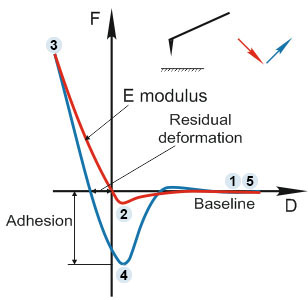HD Surface profilometry

Non-resonant oscillatory HybriD mode provides certain advantages in conventional relief imaging
- HybriD mode is an intermediate technique between Amplitude Modulation AFM and Contact AFM in terms of the force of influence of the probe on the sample surface. The impact of Jumping AFM is always more severe than in AM-AFM, but softer than in Contact AFM.
- The feedback signal in this method is the maximum force detected in each cycle (point 3 on the graph). So the Set Point value in this case is a direct measurement of force, which is much more direct compared to amplitude or phase modulation.
- Since the probe leaves contact with the sample at each cycle, the influence of lateral forces is sharply reduced, which is extremely important when studying soft and weakly fixed objects.
- AFM imaging in a vacuum is always more difficult than under normal conditions due to the enormous Q-factor of the cantilever. Therefore, you have to either use low scanning speeds, or use the Frequency Modulation method with a rather complex setup. In HybriD mode we move out of resonance, so the high Q-factor no longer plays any role.
- Imaging in liquid is also problematic due to the low Q-factor and multiple resonance peaks. Moreover, since the maximum force is calculated in relation to the baseline of each cycle, drift of the laser signal, which is a very common case in liquid media, is no longer a problem.
Visualization in a vacuum

AM-AFM in vacuum. Scanning speed 0.2 Hz

HybriD mode in vacuum. Scanning speed 1Hz






